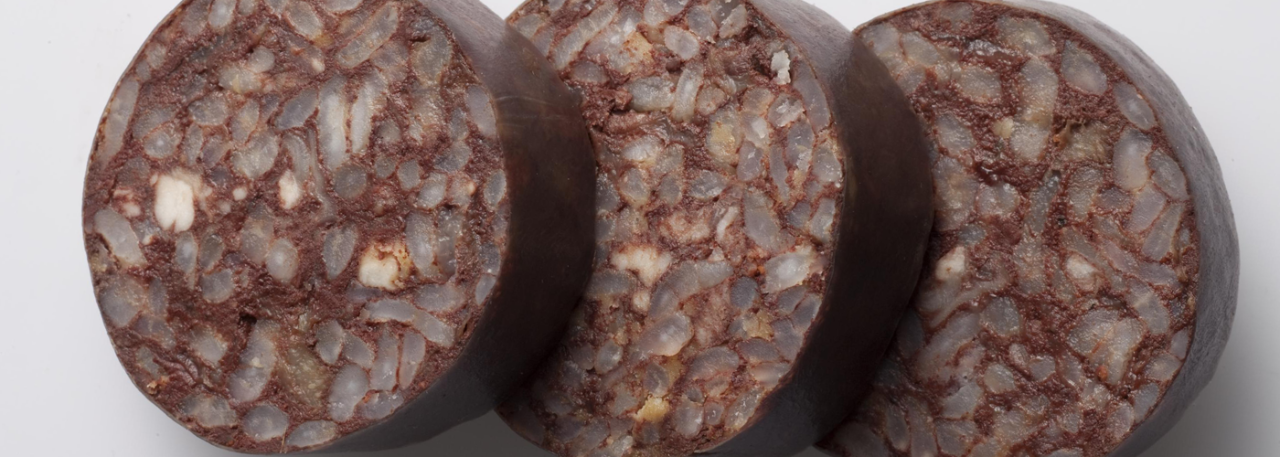.png.transform/rendition-xs/image_image%20(1).png)
Burgos black sausage
The black pudding known as morcilla de Burgos is a sausage made mostly with pork blood which, unlike other black puddings, includes rice as one of its basic ingredients. This product is made with onion of the Horcal variety, rice, pig's blood, pork lard and spices, all stuffed into a natural pork or beef casing and subjected to a cooking process.
Tasting notes
Onion aroma with a texture which varies depending on whether or not the rice is precooked. Solid consistency with the presence of agglutinations of fat, mostly lard. Spicy aroma, varying according to the production area; more aromatic and with a Mediterranean influence towards the south of the province of Burgos, and with a more intense pimentón taste in the northern areas.
There should be no grittiness in the cooked rice. An important element is the local Horcal variety of onion. This variety is native to the Burgos region, and is grown in the river valleys throughout the province.
Other notes
When sliced, it presents a range of colors from dark brown –due to the presence of blood– to an even darker color or black, based on the manufacturer's formulation and the cooking period. There may be redder tones due to the presence of pimentón. Burgos black pudding has a curved appearance and is between 5 and 7 cm in diameter by 15 or 20 cm in length.
Production / Processing method
The production process of this sausage may vary slightly depending on the place where it is made, but in general it is the following:
The intestines are washed and cut into average sizes of 15 cm, then one of the ends is sewn or tied.
Then the mixture is made by finely chopping the onion, and mixing with the lard, rice (raw or lightly cooked), blood, salt, black pepper and pimentón (other spices that can be used include cinnamon, cloves, oregano and thyme). The mixture is kneaded and left to stand. This mixture is then stuffed into the natural beef or pork casing, taking care not to fill it more than 50% full, as it can burst as the rice cooks.
Once the other end has been sewn or tied, the black puddings are cooked, and simmered gently for about an hour. They must be watched carefully throughout this process, as the morcillas which float must be pierced with a needle to prevent them from bursting due to accumulated gas. During this time they change from a reddish color to black. At the end of the cooking period they are placed on trays to air and cool.
It should be noted that one factor which marks the difference between certain black puddings and others is the atmospheric pressure due to altitude. This affects the cooking process, which may be longer or shorter depending on the altitude. In the city of Burgos, at an altitude of approximately 860 meters, the rice is not precooked but is stuffed directly into the casing raw, and then cooked. In other places in the Ribera del Duero area with altitudes of between 600 m and 700 m, the rice is cooked. This allows it to inflate and means that a smaller quantity of onion is used, thus requiring a shorter cooking time in the casing. In warmer areas in the south of the province, the cooking time is shorter in order to avoid the black puddings bursting during the cooking process.
Thus in spite of there being a common denominator, even within a relatively small territory such as the province of Burgos there may be various differences between morcillas. Thus for example it is possible to distinguish the varieties from Arlazón, Miranda de Ebro or La Cardeña, as well as from Aranda del Duero or Sotopalacios.
Geography / Relief and climate
The province of Burgos is located in the Autonomous Region of Castile-León in the northern part of Spain. It has an area of 14,291.81 km². It borders on Segovia and Soria to the south, Álava, Cantabria and Vizcaya to the north, Álava, La Rioja and Soria to the east, and Palencia and Valladolid to the west. The Duero river basin forms part of the mountain range, whereas a third of the area of the province lies within the Ebro valley.
The southeast part contains the highest uplands and mountains in the province; the San Millán peak, with a height of 2,132 m (in La Demanda mountains, part of the Sistema Ibérico mountain range) is the highest in the province, followed by the Campiña (Sierra de Neila mountains) with a height of 2,048 m and the Mencilla (Sierra de Mencilla mountains) with 1.932 m.
It should be noted that one factor which marks the difference between certain black puddings and others is the atmospheric pressure due to altitude.

